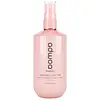What's inside
What's inside
 Key Ingredients
Key Ingredients

No key ingredients
 Benefits
Benefits

 Concerns
Concerns

 Ingredients Side-by-side
Ingredients Side-by-side

Water
Skin ConditioningCetearyl Alcohol
EmollientOrbignya Oleifera Seed Oil
EmollientParfum
MaskingGlycerin
HumectantBehentrimonium Chloride
PreservativeCetrimonium Chloride
AntimicrobialAmodimethicone
Sodium Benzoate
MaskingIsopropyl Alcohol
SolventPEG/PPG/Polybutylene Glycol-8/5/3 Glycerin
HumectantBenzyl Salicylate
PerfumingCitric Acid
BufferingBenzyl Alcohol
PerfumingLinalool
PerfumingTrideceth-6
EmulsifyingChlorhexidine Dihydrochloride
AntimicrobialHexyl Cinnamal
PerfumingGeraniol
PerfumingAmyl Cinnamal
PerfumingCoumarin
PerfumingCitronellol
PerfumingLimonene
PerfumingBenzyl Benzoate
AntimicrobialWater, Cetearyl Alcohol, Orbignya Oleifera Seed Oil, Parfum, Glycerin, Behentrimonium Chloride, Cetrimonium Chloride, Amodimethicone, Sodium Benzoate, Isopropyl Alcohol, PEG/PPG/Polybutylene Glycol-8/5/3 Glycerin, Benzyl Salicylate, Citric Acid, Benzyl Alcohol, Linalool, Trideceth-6, Chlorhexidine Dihydrochloride, Hexyl Cinnamal, Geraniol, Amyl Cinnamal, Coumarin, Citronellol, Limonene, Benzyl Benzoate
Quaternium-91
Behentrimonium Chloride
PreservativeMyristyl Myristate
EmollientCetearyl Alcohol
EmollientAloe Barbadensis Leaf Juice
Skin ConditioningCetrimonium Chloride
AntimicrobialDiheptyl Succinate
EmollientCapryloyl Glycerin/Sebacic Acid Copolymer
Skin ConditioningSimmondsia Chinensis Seed Oil
EmollientPersea Gratissima Oil
Skin ConditioningOlea Europaea Fruit Oil
MaskingArgania Spinosa Kernel Oil
EmollientFragaria Ananassa Seed Oil
AntioxidantRubus Idaeus Seed Oil
EmollientCitrullus Lanatus Seed Oil
EmollientDehydroacetic Acid
PreservativeBenzyl Alcohol
PerfumingParfum
MaskingPanthenol
Skin ConditioningHibiscus Sabdariffa Flower Powder
AbrasiveQuaternium-91, Behentrimonium Chloride, Myristyl Myristate, Cetearyl Alcohol, Aloe Barbadensis Leaf Juice, Cetrimonium Chloride, Diheptyl Succinate, Capryloyl Glycerin/Sebacic Acid Copolymer, Simmondsia Chinensis Seed Oil, Persea Gratissima Oil, Olea Europaea Fruit Oil, Argania Spinosa Kernel Oil, Fragaria Ananassa Seed Oil, Rubus Idaeus Seed Oil, Citrullus Lanatus Seed Oil, Dehydroacetic Acid, Benzyl Alcohol, Parfum, Panthenol, Hibiscus Sabdariffa Flower Powder
Ingredients Explained
These ingredients are found in both products.
Ingredients higher up in an ingredient list are typically present in a larger amount.
This ingredient is a preservative and often used for it's anti-static properties. You'll most likely see this ingredient in hair conditioners.
It does not cause irritation or sensitization in leave-on products at 1-5%.
Benzyl Alcohol is most commonly used as a preservative. It also has a subtle, sweet smell. Small amounts of Benzyl Alcohol is not irritating and safe to use in skincare products. Most Benzyl Alcohol is derived from fruits such as apricots.
Benzyl Alcohol has both antibacterial and antioxidant properties. These properties help lengthen the shelf life of products. Benzyl Alcohol is a solvent and helps dissolve other ingredients. It can also improve the texture and spreadability.
Alcohol comes in many different forms. Different types of alcohol will have different effects on skin. This ingredient is an astringent alcohol.
Using high concentrations of these alcohols are drying on the skin. They may strip away your skin's natural oils and even damage your skin barrier. Astringent alcohols may also irritate skin.
Other types of astringent alcohols include:
According to the National Rosacea Society based in the US, you should be mindful of products with these alcohols in the top half of ingredients.
Any type of sanitizing product will have high amounts of alcohol to help kill bacteria and viruses.
Learn more about Benzyl AlcoholCetearyl alcohol is a mixture of two fatty alcohols: cetyl alcohol and stearyl alcohol. It is mainly used as an emulsifier. Emulsifiers help prevent the separation of oils and products. Due to its composition, it can also be used to thicken a product or help create foam.
Cetearyl alcohol is an emollient. Emollients help soothe and hydrate the skin by trapping moisture.
Studies show Cetearyl alcohol is non-toxic and non-irritating. The FDA allows products labeled "alcohol-free" to have fatty alcohols.
This ingredient is usually derived from plant oils such as palm, vegetable, or coconut oils. There is debate on whether this ingredient will cause acne.
Due to the fatty acid base, this ingredient may not be Malassezia folliculitis safe.
Learn more about Cetearyl AlcoholThis ingredient is a preservative, antimicrobial, and emulsifier. It is often used in cosmetics for its ability to cleanse, condition, and reduce static.
Cetrimonium chloride is a quaternary ammonium salt, meaning it has a water-soluble structure.
Parfum is a catch-all term for an ingredient or more that is used to give a scent to products.
Also called "fragrance", this ingredient can be a blend of hundreds of chemicals or plant oils. This means every product with "fragrance" or "parfum" in the ingredients list is a different mixture.
For instance, Habanolide is a proprietary trade name for a specific aroma chemical. When used as a fragrance ingredient in cosmetics, most aroma chemicals fall under the broad labeling category of “FRAGRANCE” or “PARFUM” according to EU and US regulations.
The term 'parfum' or 'fragrance' is not regulated in many countries. In many cases, it is up to the brand to define this term.
For instance, many brands choose to label themselves as "fragrance-free" because they are not using synthetic fragrances. However, their products may still contain ingredients such as essential oils that are considered a fragrance by INCI standards.
One example is Calendula flower extract. Calendula is an essential oil that still imparts a scent or 'fragrance'.
Depending on the blend, the ingredients in the mixture can cause allergies and sensitivities on the skin. Some ingredients that are known EU allergens include linalool and citronellol.
Parfum can also be used to mask or cover an unpleasant scent.
The bottom line is: not all fragrances/parfum/ingredients are created equally. If you are worried about fragrances, we recommend taking a closer look at an ingredient. And of course, we always recommend speaking with a professional.
Learn more about Parfum